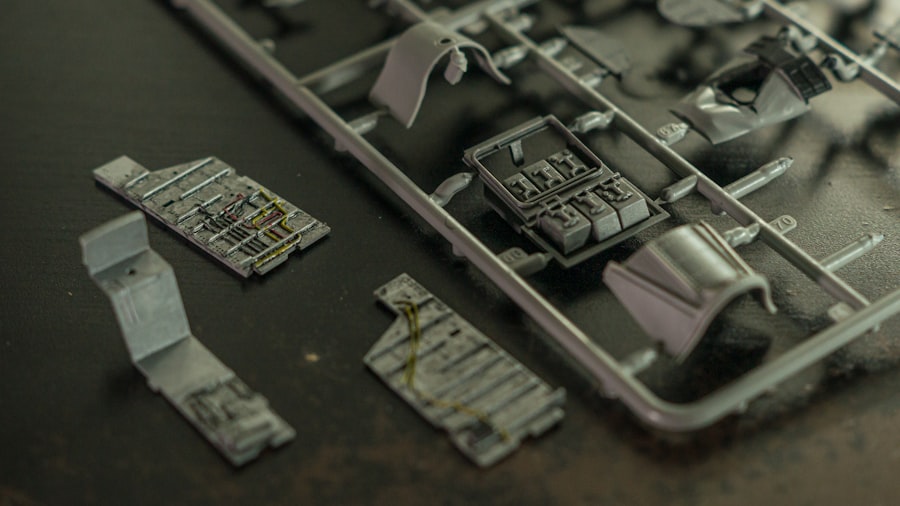The proliferation of counterfeit parts in military equipment has emerged as a significant concern for nations worldwide, and Russia is no exception. The issue is particularly pressing given the strategic importance of military readiness and the reliance on advanced technology in modern warfare. Counterfeit components can infiltrate supply chains, undermining the integrity of military gear and potentially jeopardizing national security.
As Russia continues to modernize its military capabilities, the presence of counterfeit parts poses a serious threat to the effectiveness and reliability of its armed forces.
The Russian military, like many others, operates within a vast network of suppliers and subcontractors, making it challenging to maintain oversight and ensure the authenticity of every component.
This situation creates fertile ground for counterfeiters who exploit vulnerabilities in the supply chain. As a result, the Russian military faces an uphill battle in safeguarding its equipment from substandard or fraudulent parts that could compromise operational effectiveness.
Key Takeaways
- Counterfeit parts in Russian military gear pose a significant threat to the effectiveness and safety of the equipment.
- The sources and distribution of counterfeit parts for Russian military gear are widespread and difficult to track.
- Detecting counterfeit parts in Russian military equipment is a major challenge due to the complexity and sophistication of modern technology.
- The risks and dangers posed by counterfeit parts in Russian military gear include equipment malfunction, compromised national security, and potential loss of life.
- International cooperation is crucial in addressing the issue of counterfeit parts in Russian military equipment, and efforts to combat this problem are ongoing.
The Impact of Counterfeit Parts on the Effectiveness of Russian Military Equipment
Counterfeit parts can have dire consequences for the performance of military equipment. When substandard components are integrated into critical systems, they can lead to malfunctions, reduced operational capabilities, and even catastrophic failures during missions. For instance, counterfeit electronic components may not meet the rigorous standards required for military applications, resulting in unreliable communication systems or navigation failures.
Such deficiencies can severely hinder a unit’s ability to execute its objectives effectively. Moreover, the presence of counterfeit parts can erode the confidence of military personnel in their equipment. Soldiers rely on their gear to perform under pressure, and knowing that their equipment may contain counterfeit components can lead to hesitation and uncertainty in high-stakes situations.
This psychological impact can be just as damaging as any physical malfunction, as it undermines the overall morale and effectiveness of the troops. In a military context, where trust in equipment is paramount, the ramifications of counterfeit parts extend beyond mere technical failures.
The Sources and Distribution of Counterfeit Parts for Russian Military Gear

The sources of counterfeit parts are diverse and often involve a complex web of illicit networks. In many cases, counterfeiters operate in regions with lax regulatory oversight, where they can produce and distribute fake components with relative impunity. These counterfeit parts may originate from unauthorized manufacturers or even be repurposed from obsolete civilian equipment.
The ease with which counterfeiters can access technology and materials has made it increasingly difficult for authorities to track and eliminate these threats. Distribution channels for counterfeit parts are equally concerning. They often exploit legitimate supply chains, infiltrating them at various stages—from manufacturing to distribution.
This infiltration can occur through unscrupulous suppliers who prioritize profit over quality or through cyberattacks that compromise inventory systems. The result is a situation where counterfeit parts can seamlessly enter the military supply chain, making detection and prevention exceedingly challenging for Russian authorities.
The Challenges of Detecting Counterfeit Parts in Russian Military Equipment
| Challenges | Impact |
|---|---|
| Lack of standardized authentication methods | Increases the difficulty of identifying counterfeit parts |
| Complex global supply chain | Makes it harder to trace the origin of parts |
| High demand for military equipment | Creates opportunities for counterfeiters to infiltrate the market |
| Technological advancements in counterfeiting | Makes it easier for counterfeiters to produce convincing fake parts |
Detecting counterfeit parts within military equipment presents a formidable challenge for Russian authorities. The sophistication of counterfeiters has increased significantly, with many employing advanced techniques to replicate genuine components closely. This level of sophistication makes it difficult for even trained personnel to distinguish between authentic and counterfeit parts without specialized testing equipment.
Additionally, the sheer volume of components used in military gear complicates detection efforts. The Russian military relies on a vast array of equipment, from small arms to complex missile systems, each containing numerous individual parts. Conducting thorough inspections on every component is not only time-consuming but also resource-intensive.
As a result, there is often a reliance on visual inspections or basic testing methods that may not be sufficient to identify counterfeit items effectively.
The Risks and Dangers Posed by Counterfeit Parts in Russian Military Gear
The risks associated with counterfeit parts extend beyond mere operational failures; they pose significant dangers to personnel and national security. In combat situations, equipment failures caused by counterfeit components can lead to loss of life or mission failure. For example, if a critical weapon system malfunctions due to a counterfeit part, it could leave soldiers vulnerable to enemy fire or unable to complete their objectives.
Furthermore, the presence of counterfeit parts can have broader implications for national security. If adversaries become aware of vulnerabilities within the Russian military’s equipment due to counterfeit components, they may exploit these weaknesses strategically. This could lead to a loss of confidence in Russia’s military capabilities both domestically and internationally, potentially emboldening adversaries and destabilizing regional security dynamics.
Efforts to Combat Counterfeit Parts in Russian Military Gear

In response to the growing threat posed by counterfeit parts, Russian authorities have initiated various efforts aimed at combating this issue. One approach involves enhancing regulatory frameworks governing military procurement and supply chains. By implementing stricter oversight measures and establishing clearer guidelines for suppliers, authorities hope to reduce the likelihood of counterfeit components entering the system.
Additionally, there has been an emphasis on improving detection technologies and methodologies within the military. Investing in advanced testing equipment and training personnel to recognize counterfeit components is crucial for safeguarding military readiness. Collaborative efforts with industry partners and research institutions can also play a vital role in developing innovative solutions to identify and eliminate counterfeit parts from military gear.
Case Studies of Incidents Caused by Counterfeit Parts in Russian Military Equipment
Several incidents have highlighted the dangers posed by counterfeit parts within Russian military equipment. One notable case involved a series of aircraft malfunctions attributed to counterfeit electronic components that had been integrated into fighter jets. These malfunctions not only grounded several aircraft but also raised concerns about the overall safety and reliability of Russia’s air force capabilities.
Another incident involved ground vehicles that experienced critical failures during training exercises due to counterfeit engine components. The resulting breakdowns not only disrupted training but also exposed personnel to unnecessary risks during operations. Such incidents underscore the urgent need for comprehensive measures to address the infiltration of counterfeit parts into military gear.
The Economic and Political Implications of Counterfeit Parts in Russian Military Gear
The economic implications of counterfeit parts extend beyond immediate operational concerns; they can also have far-reaching effects on Russia’s defense industry and economy as a whole. The presence of substandard components can lead to increased maintenance costs, reduced lifespan for equipment, and ultimately higher expenditures for the military budget. This financial strain can divert resources away from other critical areas within the defense sector.
Politically, the issue of counterfeit parts can undermine public confidence in government institutions responsible for national defense. If citizens perceive that their military is compromised by substandard equipment due to counterfeiting, it could lead to calls for accountability and reform within the defense establishment. This erosion of trust may have broader implications for national unity and support for defense initiatives.
The Role of International Cooperation in Addressing the Issue of Counterfeit Parts in Russian Military Equipment
Addressing the problem of counterfeit parts requires international cooperation and collaboration among nations facing similar challenges. Sharing best practices, intelligence, and technological advancements can enhance detection efforts and strengthen supply chain integrity across borders. Collaborative initiatives involving multiple countries can create a unified front against counterfeiting networks that operate transnationally.
Furthermore, international partnerships can facilitate joint training programs aimed at equipping military personnel with the skills needed to identify and combat counterfeit components effectively. By fostering collaboration among nations, Russia can leverage collective expertise to bolster its defenses against this pervasive threat.
The Future Outlook for Preventing and Addressing Counterfeit Parts in Russian Military Gear
Looking ahead, the future outlook for preventing and addressing counterfeit parts in Russian military gear hinges on several key factors.
Additionally, fostering a culture of accountability within supply chains will be crucial for mitigating risks associated with counterfeiting.
Moreover, as global supply chains evolve, adapting strategies to address emerging threats will be vital. This may involve leveraging advancements in blockchain technology or artificial intelligence to enhance traceability and authenticity verification processes within military procurement systems.
The Importance of Addressing the Problem of Counterfeit Parts in Russian Military Gear
In conclusion, the issue of counterfeit parts in Russian military gear represents a multifaceted challenge with significant implications for national security, operational effectiveness, and public trust in defense institutions. As Russia navigates an increasingly complex geopolitical landscape, addressing this problem will be paramount for ensuring that its armed forces remain capable and reliable. By prioritizing efforts to combat counterfeiting through enhanced regulations, improved detection technologies, and international cooperation, Russia can take meaningful steps toward safeguarding its military readiness against this pervasive threat.
Ultimately, addressing the problem of counterfeit parts is not just about protecting equipment; it is about preserving national security and maintaining confidence in the integrity of the armed forces.
In recent years, the issue of counterfeit parts in Russian military gear has raised significant concerns about the reliability and safety of their equipment. This problem not only affects the operational effectiveness of the Russian military but also poses a broader threat to global security. For a deeper understanding of the implications and the extent of this issue, you can read a related article on the topic by visiting In The War Room. This article delves into the complexities of counterfeit components and their impact on military readiness and international relations.
WATCH NOW! 🎖️ Plot Twist: Russia’s Military Is Being Eaten Alive By Its Own Corruption
FAQs
What are counterfeit parts in Russian military gear?
Counterfeit parts in Russian military gear are components or materials that are falsely labeled or misrepresented as genuine, but are actually substandard, imitation, or unauthorized copies.
How do counterfeit parts affect Russian military gear?
Counterfeit parts can compromise the performance, reliability, and safety of Russian military gear. They can also lead to increased maintenance costs and potential failures in critical situations.
What are the risks of using counterfeit parts in Russian military gear?
The use of counterfeit parts in Russian military gear can pose significant risks, including reduced operational effectiveness, increased vulnerability to enemy actions, and potential harm to military personnel.
How are counterfeit parts detected in Russian military gear?
Counterfeit parts in Russian military gear can be detected through rigorous quality control measures, including thorough inspection, testing, and verification of the authenticity of components and materials.
What measures are being taken to address the issue of counterfeit parts in Russian military gear?
Efforts are being made to combat the proliferation of counterfeit parts in Russian military gear, including the implementation of stricter procurement and supply chain management practices, as well as increased collaboration with industry partners and law enforcement agencies.




